Have you ever gazed at your outdoor deck and felt that spark of possibility? That nagging feeling that with just the right touch, your ordinary wooden platform could transform into something extraordinary? I certainly have. After fifteen years in landscape design and outdoor renovation, I’ve seen countless decks evolve from forgotten spaces to breathtaking extensions of the home.
Your deck is more than just a structure attached to your house. It’s an opportunity. A canvas awaiting your creative vision.
Let’s find out 25 deck ideas that could revolutionize your outdoor living space. These aren’t your run-of-the-mill suggestions you’d find in every home magazine. These are tried-and-tested concepts that’ll make your neighbors peek over the fence with undisguised envy.
1. Multi-Level Magic
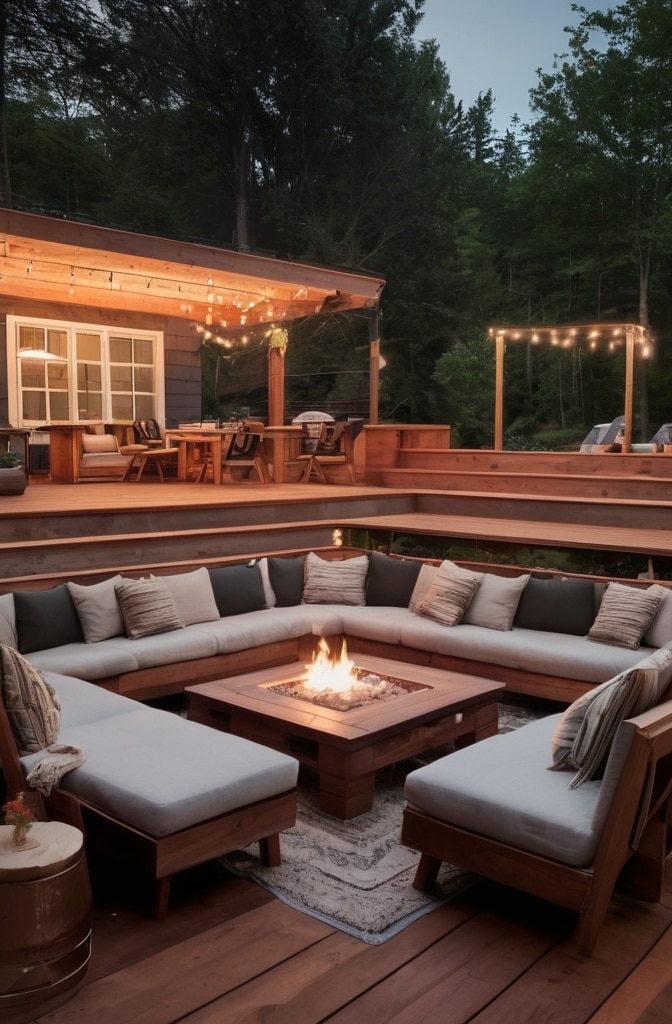
Traditional single-level decks? Honestly, they’re a bit passé. Multi-level decking creates visual interest and defines different zones for various activities.
Imagine stepping down from your dining area to a cozy lounging space, then another level down to your hot tub zone. Each level creates a natural transition between spaces without the need for walls or dividers. The varying heights add depth to your yard, making even smaller spaces feel grand and purposeful.
I’ve seen homeowners use just a 6-inch difference between levels to create stunning visual seperation. It don’t have to be dramatic to be effective.
2. Integrated Planters That Wow
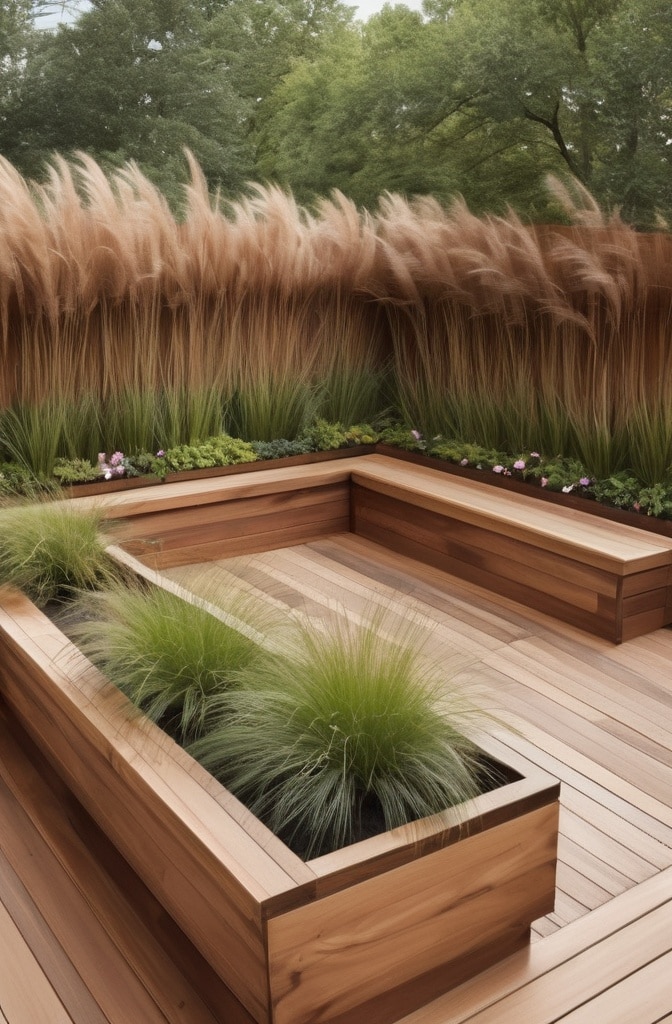
Built-in planters aren’t exactly revolutionary, but strategic placement can transform your deck’s entire feel.
Rather than placing pots around the perimeter, consider integrating planters directly into your deck design. Use them as natural railings, privacy screens, or to delineate spaces. Filled with cascading flowers, ornamental grasses, or even small trees, these living boundaries soften the harsh lines of decking materials and bring nature into your design.
My clients in Seattle incorporated cedar planters that matched they’re decking, creating a seamless look that blurred the line between hardscape and landscape. The fragrance of herbs and seasonal blooms made the space feel alive in a way that furniture alone never could.
3. Covered Pergola Paradises
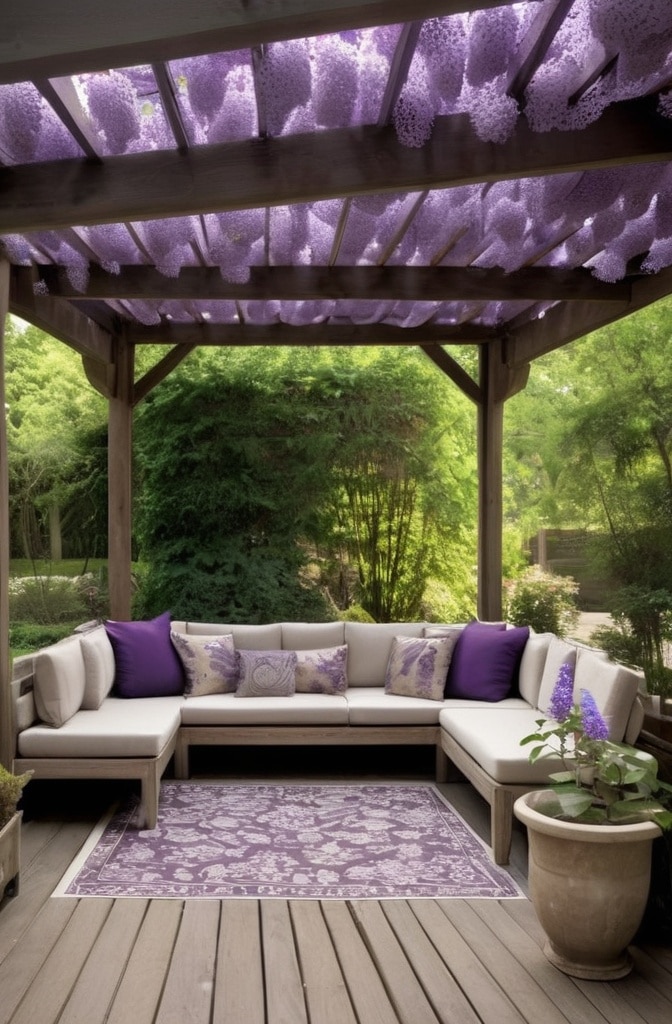
Weather shouldn’t dictate when you can enjoy your deck. A pergola provides that perfect balance of shelter and openness.
Modern pergola designs have evolved far beyond the basic crossed-beam structures of yesteryear. Retractable canopies, adjustable louvers, and integrated lighting systems transform these simple structures into sophisticated outdoor rooms. Add climbing vines like wisteria or jasmine, and you’ve created a living ceiling that provides dappled shade and intoxicating fragrance.
The best part? You can customize the coverage based on your climate needs more open in cooler regions, more protected in areas with intense sun or frequent rain.
4. Fire and Water Features

Nothing captivates like the primal elements of fire and water. Incorporating one (or both!) into your deck design creates an instant focal point.
A sunken fire pit surrounded by built-in seating becomes the natural gathering spot on cool evenings. Meanwhile, water features from simple bubbling fountains to dramatic waterfall walls add soothing sounds that mask neighborhood noise and create a sense of tranquility.
I worked with a family in Arizona who combined both elements in they’re deck design. A fire table centered in a small reflecting pool created this mesmerizing contrast that kept guests lingering long after dinner was finished.
5. Hidden Tech Integration

Today’s outdoor spaces can be just as sophisticated as indoor ones, but the key is keeping technology discreet.
Weatherproof speakers disguised as landscape rocks, pop-up TV lifts that remain hidden when not in use, automated lighting systems controlled by your smartphone these elements enhance your deck experience without compromising its natural aesthetic. Even charging stations can be integrated into deck rails or side tables.
The goal isn’t to replicate your indoor media room, but to subtly incorporate conveniences that enhance your outdoor lifestyle.
6. Dramatic Deck Lighting

Lighting transforms a deck from merely functional to absolutely magical after sunset. But I’m not talking about basic wall sconces.
Think layers of illumination: recessed lights in stair risers for safety, uplighting on architectural features or trees adjacent to your deck, string lights creating a starry canopy overhead, and perhaps subtle LED strips outlining the deck’s perimeter. Diffrent lighting zones controlled independently allow you to create the perfect ambiance for any occasion.
The best deck lighting creates pools of light and shadow rather then flat, even illumination. It’s about creating mood, not just visibility.
7. Mixed Material Masterpieces
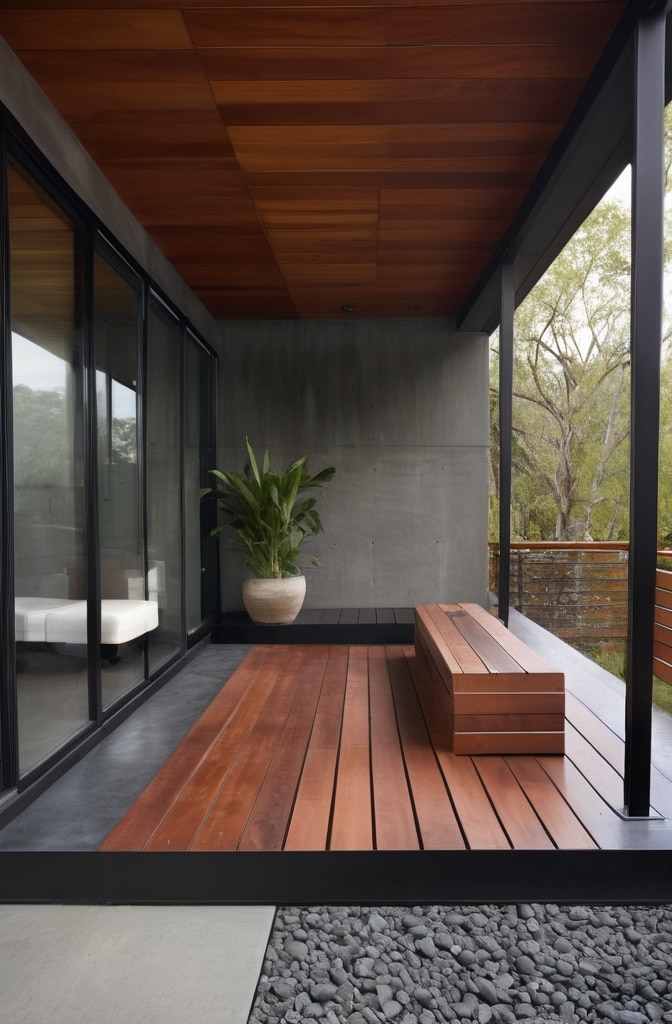
Who says your deck must be built from a single material? Combining materials creates visual interest and practical benefits.
Imagine composite decking bordered by porcelain tiles, or sections of ipe wood inlaid within a field of concrete pavers. These material transitions can delineate spaces naturally perhaps wood for the dining area, and stone surrounding a fire feature for safety and visual contrast.
I recently designed a deck that transitioned from traditional timber near the house to steel and glass sections that extended over a sloped yard, creating the sensation of floating among the treetops. The mix of warm wood and industrial materials created a stunning juxtaposition.
8. Outdoor Kitchen Expansion
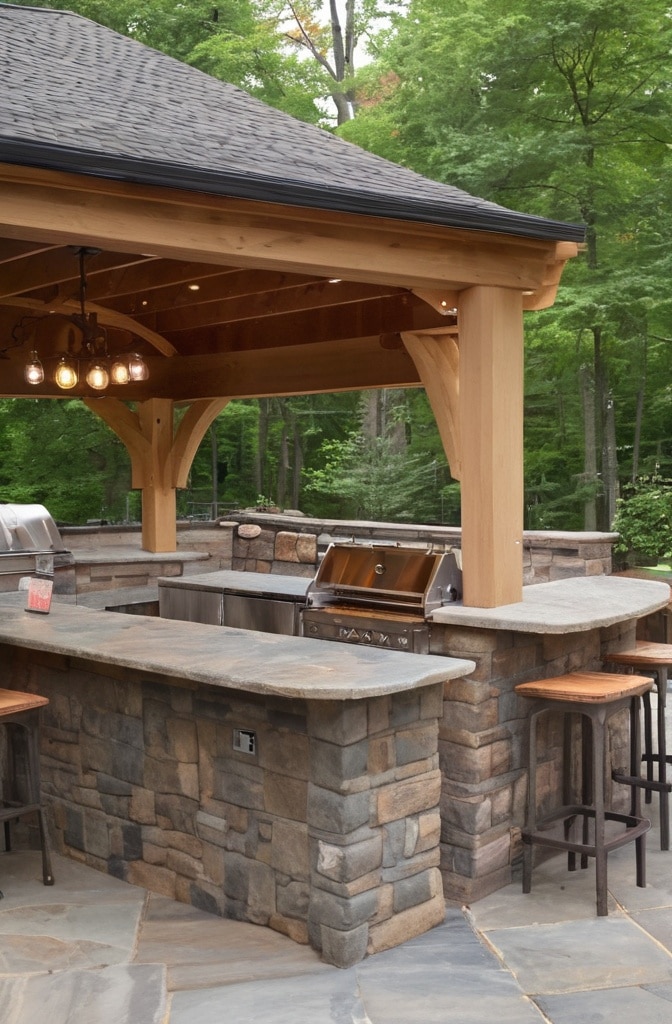
Basic grills are giving way to comprehensive outdoor kitchens that rival their indoor counterparts.
Today’s deck-integrated cooking spaces feature weather-resistant cabinetry, specialized appliances from pizza ovens to smokers, refrigeration, and even dishwashers designed for outdoor use. The key is designing these spaces to withstand your specific climate while providing the functionality you truly need.
One of my favorite projects featured a horseshoe-shaped outdoor kitchen with a bar-height counter that allowed the cook to remain part of the conversation while preparing meals. We positioned it to shield guests from prevailing winds while maintaining the view.
9. Privacy Screens With Personality
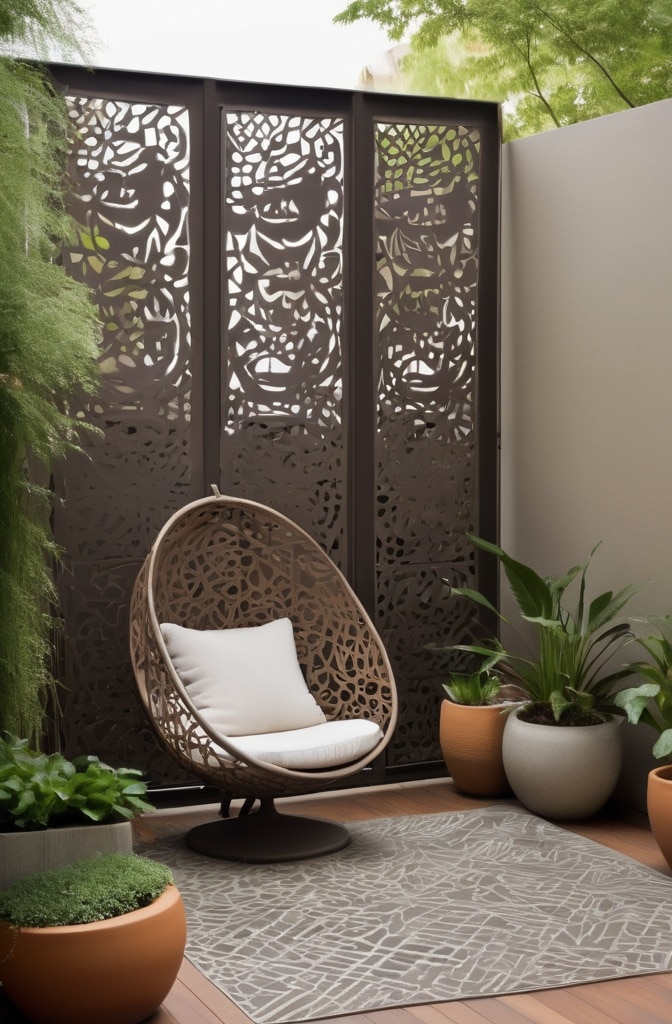
As outdoor living becomes more popular, privacy becomes more precious. Creative screening solutions offer seclusion without sacrificing style.
Laser-cut metal panels casting intricate shadows, slatted wooden walls that filter light while blocking views, or even living green walls covered in trailing vines—these elements add artistic interest while creating intimate spaces. Position them strategically to block sightlines from neighboring properties or to shield seating areas from street view.
The best privacy screens serve multiple purposes: creating intimacy, adding architectural interest, and perhaps filtering harsh sunlight or acting as a windbreak.
10. Seamless Indoor-Outdoor Transition
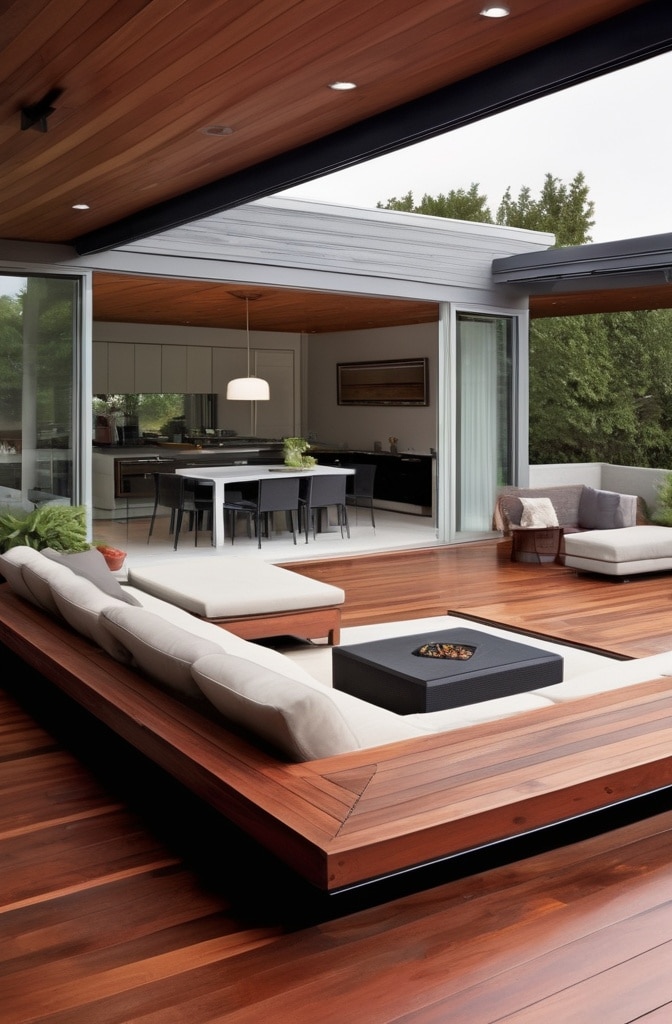
The most successful decks feel like natural extensions of your home’s interior, not afterthoughts tacked onto the building.
Consider materials that complement your interior flooring, perhaps even at the same level for an uninterrupted flow. Wall-sized sliding glass doors that pocket completely away create that coveted vanishing threshold between inside and out. Even echoing interior color schemes and materials in your outdoor furniture reinforces this connection.
I’ve worked with architects to design roof lines that extend over portions of the deck, further blurring the distinction between indoor and outdoor spaces and creating protected transitional zones.
11. Curved and Organic Shapes

Rectangle decks are functional but predictable. Curves, angles, and organic shapes transform ordinary decks into extraordinary destinations.
Curved deck sections can embrace a beautiful view, wrap around a specimen tree, or simply add visual interest to an otherwise boxy space. While admittedly more challenging to build, these non-linear designs create a custom look that responds to your specific property and lifestyle.
One homeowner I worked with wanted to preserve a mature oak in their yard, so we designed a deck with a perfect circle cutout surrounding the trunk. As the tree grew, it became this spectacular living sculpture rising through the deck plane.
12. Convertible Deck Features

The most versatile decks include elements that can transform to serve multiple purposes.
Benches with hinged tops that open for storage. Table surfaces that rise or lower to transition from dining to lounging height. Even sections of decking that can slide to reveal hot tubs or plunge pools when desired and provide extra floor space when covered.
These adaptable features maximize functionality without requiring a larger footprint, perfect for urban settings where space comes at a premium.
13. Unexpected Materials and Treatments

Traditional pressure-treated lumber is just one option among dozens of innovative decking materials available today.
Reclaimed railroad ties, weathered barn wood, or industrial metal grating can all be repurposed into distinctive decking. Even conventional materials can be treated unconventionally like wood charred using the Japanese shou sugi ban technique, which creates a dramatic black finish that’s naturally weather and insect resistant.
I’ve seen stunning decks crafted from everything from recycled plastic lumber to tempered glass panels that allow light to pass through to areas underneath. The possibilities are nearly endless.
14. Seasonal Adaptability

The ideal deck should be enjoyable across multiple seasons, not just during perfect weather.
Retractable awnings or shade sails provide relief during summer heat but can be removed for winter sunlight. Overhead infrared heaters extend usability into cooler months. Windscreens that slide or fold away maintain flexibility. Even built-in drainage systems designed to handle snow melt or heavy rain keep your deck functional year-round.
A client in Minnesota incorporated a snow-melting system beneath they’re decking hidden heating elements that prevented ice buildup and extended their outdoor enjoyment well into winter months.
15. Sustainable and Eco-Friendly Approaches

Today’s homeowners increasingly prioritize environmental responsibility in their outdoor spaces.
Sustainably harvested woods, recycled composite materials, solar-powered lighting, and rainwater collection systems integrated into deck design all minimize environmental impact. Native plantings in built-in containers support local wildlife and reduce water requirements.
One particularly innovative project featured a deck partially constructed from plastic lumber made from ocean-recovered waste plastic. The homeowners appreciated both the durability of the material and the environmental story it represented.
16. Floating Cantilevered Sections
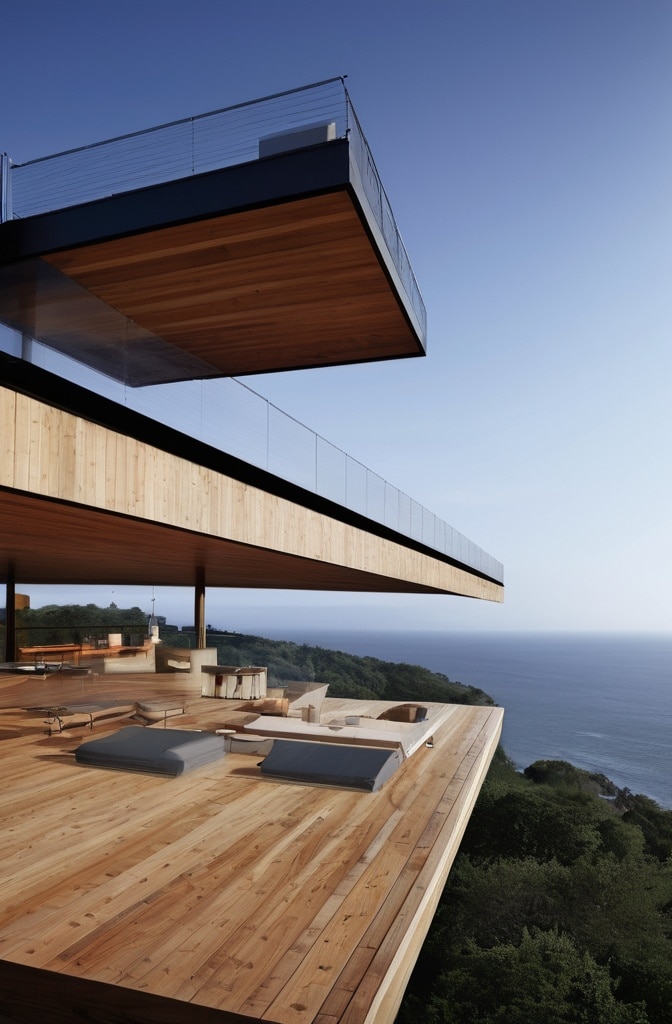
Why should your deck be firmly planted when it could seemingly defy gravity? Cantilevered deck extensions create dramatic visual impact.
These architectural wonders extend outward without visible support underneath, appearing to float above your landscape. The engineering requires proper structural reinforcement, but the effect is absolutely worth it. Imagine a portion of your deck jutting out over a sloping yard, a water feature, or simply extending beyond the main footprint to capture a specific view.
I worked with a couple in Colorado who’s cantilever deck section extended eight feet beyond its support, creating this breathtaking lookout that made guests actually gasp when they first stepped onto it. The thrill of that floating sensation never gets old, even for the homeowners who experience it everyday.
17. Conversation Pits
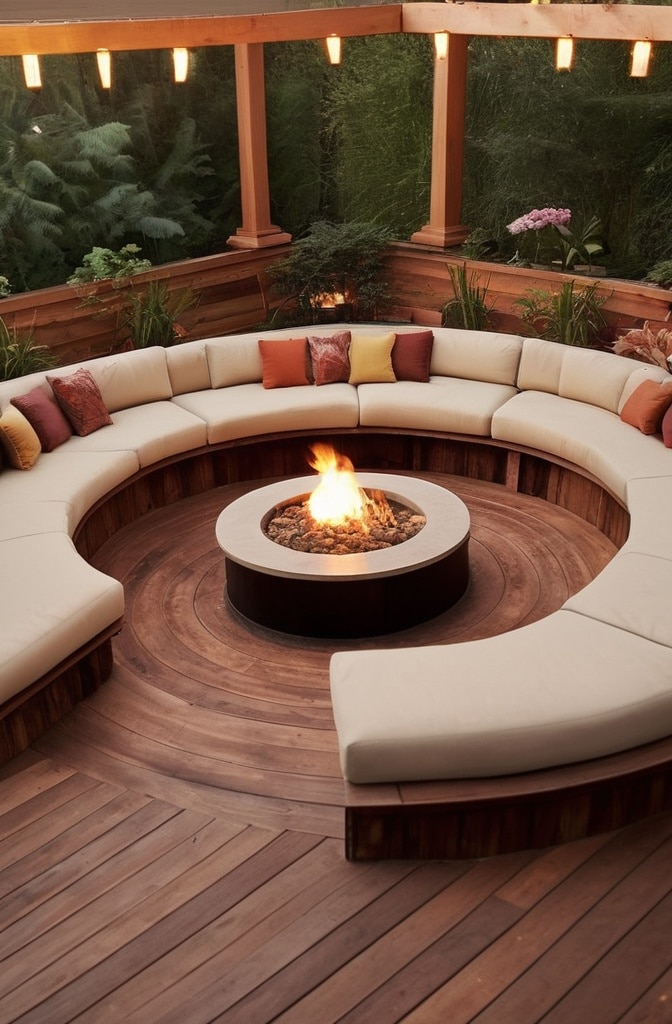
Remember those sunken living rooms from the 1970s? They’re making a spectacular comeback in outdoor deck design.
A lowered section within your deck typically 12-24 inches below the main level instantly creates an intimate gathering space. Surround it with built-in seating, add plush cushions, perhaps center it around a fire feature, and you’ve created the natural heart of your outdoor entertaining area. These sunken spaces create natural wind protection and a feeling of cozy enclosure.
The psychological effect is fascinating; people instinctively gather in these lowered spaces, conversations flow more easily, and the physical act of stepping down into the space creates a subtle transition from “passing through” to “settling in.”
18. Integrated Art Installations
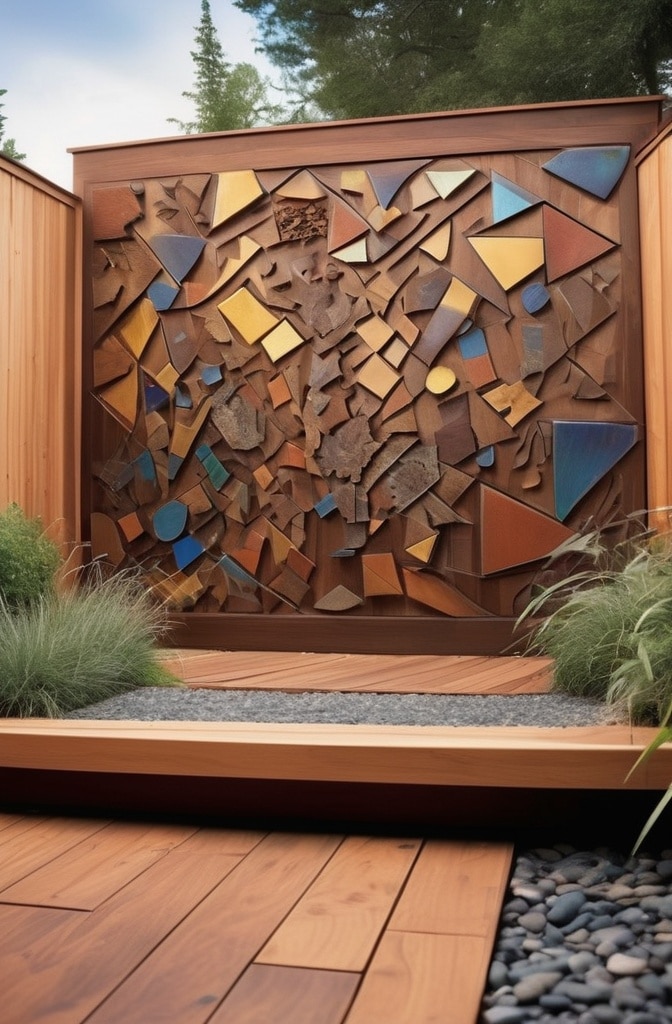
Your deck can be more than functional it can be an artistic statement that reflects your personality.
Consider commissioning custom metalwork screens that cast artistic shadows as the sun moves. Install a sculptural focal point designed specifically for your space. Even the decking itself can become an artistic canvas through inlaid designs created with contrasting materials or intricate pattern layouts.
One of the most memorable decks I’ve designed featured a incredible mosaic created from colored glass inlaid between decking boards. When the sun hit it just right, it cast these vibrant colored reflections across the space that transformed throughout the day.
19. Yoga/Meditation Platforms
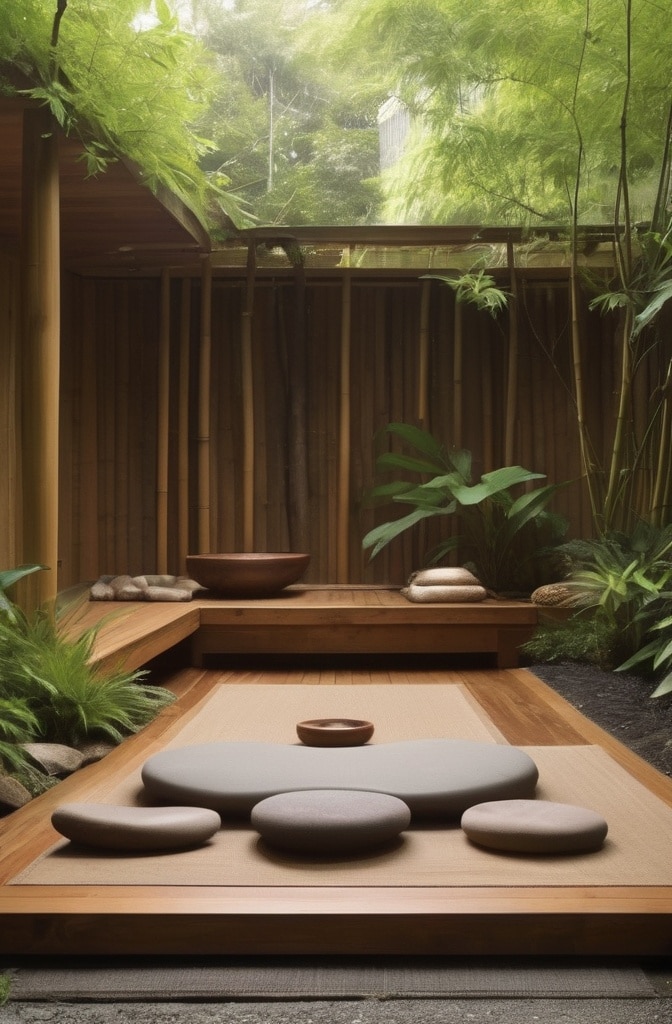
Dedicated wellness spaces have become increasingly popular as homeowners seek tranquility in their own yards.
A slightly elevated platform positioned to catch morning light, perhaps surrounded by bamboo or tall grasses for privacy, creates the perfect spot for your wellness practice. Design considerations might include built-in holders for yoga props, orientation toward inspiring views, and surfaces gentle enough for barefoot comfort.
These spaces don’t need to be large even a 6′ x 8′ platform can create that crucial separation from the rest of your deck that signals “this space has a special purpose.”
20. Hammock Havens

Hammocks are no longer just casual additions they’re becoming integrated architectural elements in modern deck design.
Built-in hammock frames that accommodate permanent installation eliminate the need for trees or posts. Recessed deck sections specifically sized for hanging beds create dedicated relaxation zones. Some designs even feature multiple hammocks in conversational arrangements, challenging the notion that these are solitary retreats.
I designed what we called a “hammock garden” for a family in Florida five hammocks arranged in a rough circle, allowing multiple family members to lounge simultaneously while still being able to converse comfortably. It became they’re favorite spot for evening stargazing.
21. Outdoor Movie Theaters
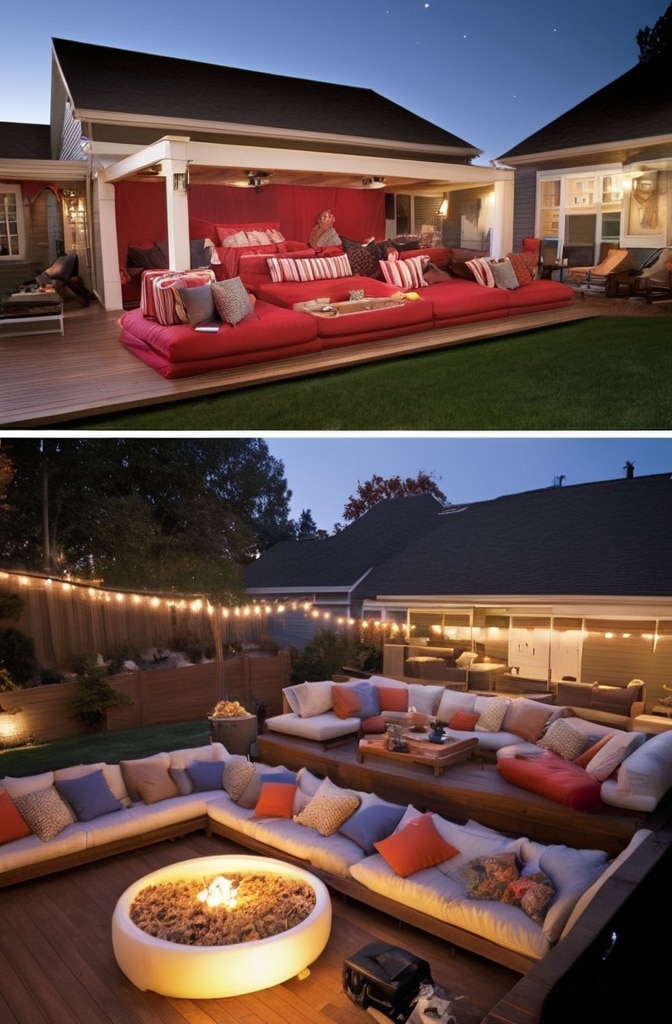
Transform your deck into an entertainment venue with a dedicated outdoor cinema setup.
Beyond simply mounting a television, consider a retractable projection screen that disappears when not in use, built-in surround sound speakers disguised within planters or deck elements, and perhaps tiered seating for optimal viewing. Automated lighting that dims with the touch of a button completes the theatrical experience.
The key difference between this and basic outdoor TVs is the intentional design—creating a true viewing environment rather than just placing a screen outdoors.
22. Interactive Water Features

Water features can be more than decorative they can be interactive elements that transform the deck experience.
Consider deck-integrated splash pads for children that can be activated when desired and remain flush with decking when not in use. Gentle bubbling fountains with seating ledges allow for cooling off during hot days. Some designs even incorporate narrow water channels running through the decking itself, creating delightful sensory moments as you move through the space.
A family in Texas incorporated what they call a “cool deck” a section with misters integrated into the pergola above and tiny water jets embedded in the decking that create a refreshing microclimate on hot days without getting furniture wet.
23. Transforming Furniture Systems
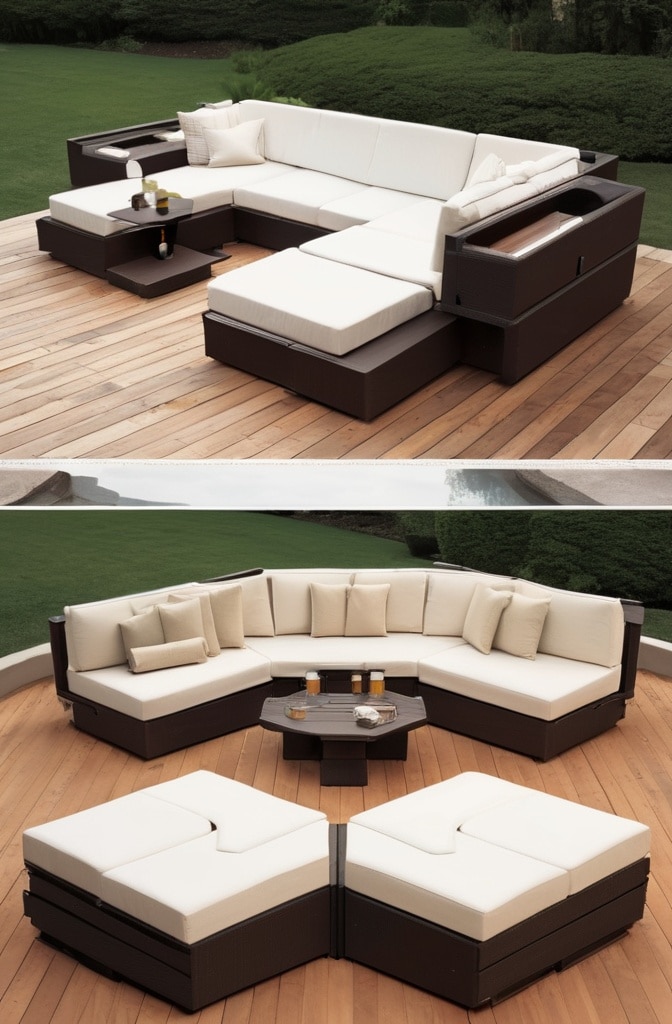
Custom-designed furniture systems that transform with your needs can revolutionize how you use your deck.
Imagine modular pieces that reconfigure from dining arrangements to lounging setups, tables that raise or lower to accommodate different activities, or bench seating that converts into sheltered day beds. These pieces become architectural elements rather than just furniture, often built with the same materials as your decking for visual cohesion.
I worked with a furniture designer to create a incredible system for a small urban deck what appeared to be a simple wooden bench could unfold into a dining table with seating for six, then transform again into a lounger for sunbathing. The space-saving design allowed the homeowners to maximize they’re limited square footage.
24. Children’s Play Integration
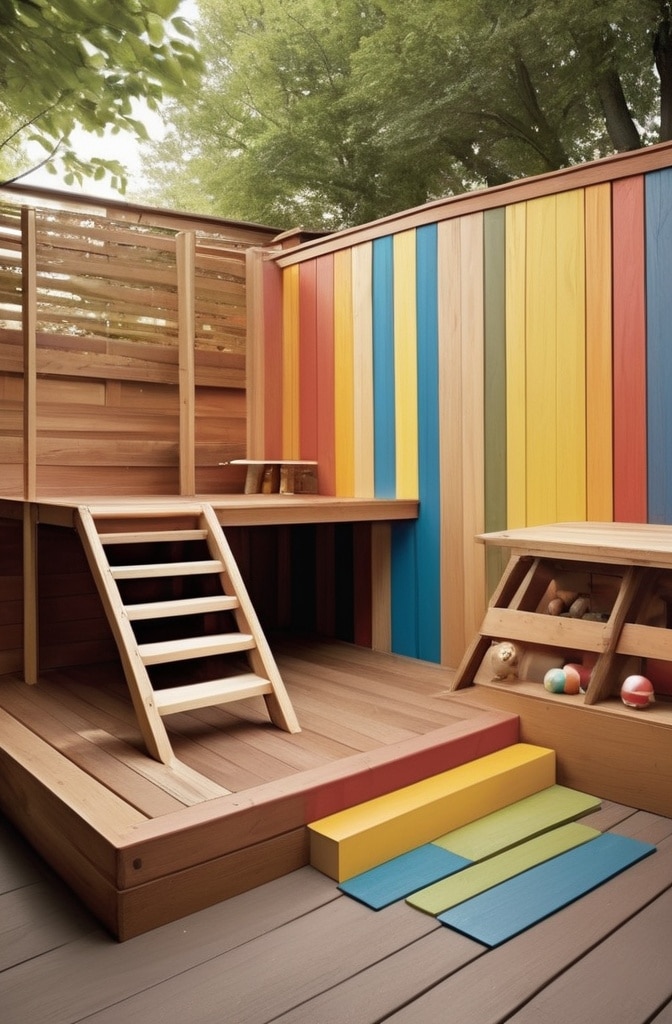
Family-friendly decks can incorporate play elements without sacrificing sophisticated design.
Climbing walls disguised as architectural privacy screens, built-in game tables for chess or checkers, slides integrated between deck levels, or even secret hideaway spaces beneath raised deck sections all add child-friendly functionality within a grown-up aesthetic. The goal is creating multigenerational spaces that don’t scream “playground” but still engage younger family members.
One particularly clever design included decking sections that lifted to reveal sandboxes covered when adult entertaining was the priority, accessible when children needed play space.
25. Stargazing Optimization
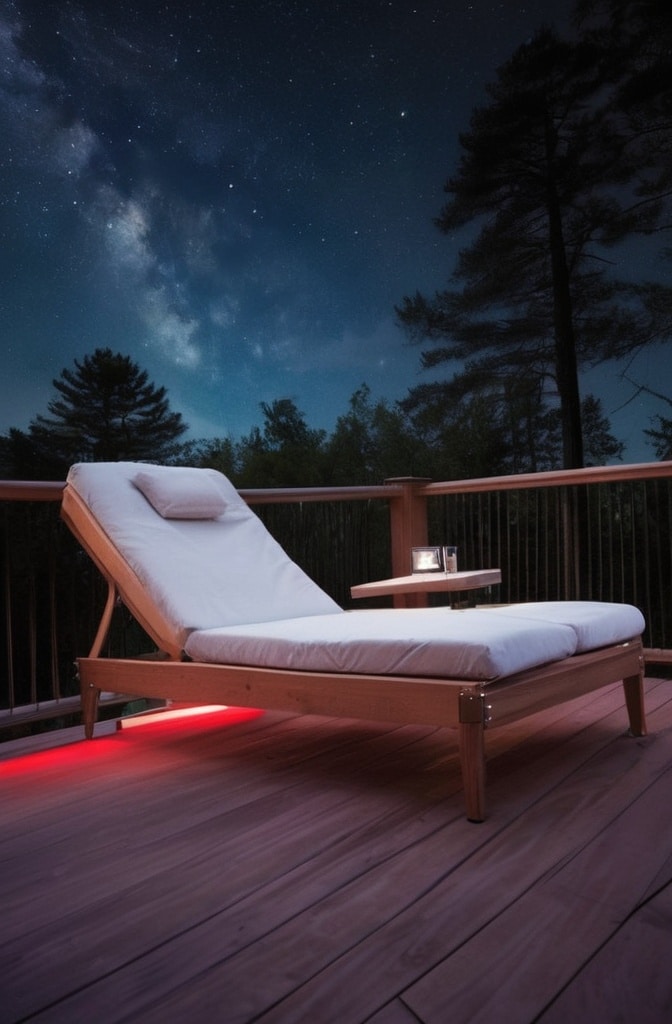
For astronomy enthusiasts or anyone who appreciates the night sky, deck features can enhance your celestial viewing experience.
Reclining loungers permanently positioned for optimal sky viewing, deck sections with reduced railing heights (where code allows) to maximize visibility, or even telescope platforms with power connections and specialized non-glare lighting transform your deck into an amateur observatory. Some designs incorporate dome covers that can be deployed in light rain but maintain clear views overhead.
A retired astronomer I worked with incorporated a dedicated viewing platform elevated above the main deck it featured a rotating floor that allowed his telescope to track celestial bodies without having to constantly reposition the heavy equipment. It was specialized, but absolutely perfect for his passion.
Conclusion:
A truly exceptional deck isn’t defined by trends or flashy features it’s one that reflects your lifestyle and meets your specific needs. Whether it’s a peaceful yoga platform with planters or a dramatic cantilevered section for entertaining, the best designs are intentional and personal.
Simplicity often leads to the most satisfying results when paired with quality materials and thoughtful planning. The key is to focus on how you’ll actually use the space and what brings you joy outdoors. Your dream deck doesn’t have to be elaborate it just needs to be yours. Start with what matters most, and let that guide your design.
